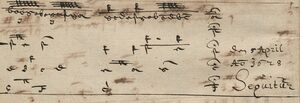M. W. C. B. M.: Difference between revisions
am.b 340 was not written by Karges. |
Fiskfan1999 (talk | contribs) |
||
| (One intermediate revision by the same user not shown) | |||
| Line 5: | Line 5: | ||
It appears that either [[Max Seiffert]] (who inspected the [[Lynar Tablatures|Lynar B]] tablatures) or [[Hans Joachim Moser]] (who published the ''editio princeps'' of these works) was the first musicologist to suggest the connection to [[Wilhelm Karges]]. They speculated that the initials stood for ''Magister Wilhelm Carges Berolinensis Marchicus''. Karges would have been only 15 years old according to the year 1628 found in the manuscript. Moser stated that Karges was one of the scribes of this manuscript, which would explain the appearance of one of his pieces. | It appears that either [[Max Seiffert]] (who inspected the [[Lynar Tablatures|Lynar B]] tablatures) or [[Hans Joachim Moser]] (who published the ''editio princeps'' of these works) was the first musicologist to suggest the connection to [[Wilhelm Karges]]. They speculated that the initials stood for ''Magister Wilhelm Carges Berolinensis Marchicus''. Karges would have been only 15 years old according to the year 1628 found in the manuscript. Moser stated that Karges was one of the scribes of this manuscript, which would explain the appearance of one of his pieces. | ||
As pointed out by [[Klaus Beckmann]], the assertion that Karges was a scribe of '''Ms. Lynar B 3''' is shown to be false when comparing it to [[D-B Am.B 340]], which was written by | As pointed out by [[Klaus Beckmann]], the assertion that Karges was a scribe of '''Ms. Lynar B 3''' is shown to be false when comparing it to [[D-B Am.B 340]], which was likely written by Karges<ref>''20 Freie Orgelwerke der Norddeutschen Schule.'' [[Meister der Norddeutschen Orgelschule]] 29. Mainz: Schott, 2013. p.81.</ref>. (see [[D-B Am.B 340#Scribe|D-B Am.B 340]]). | ||
Around 1958, an opposing view to that of Moser was developed by [[Margarete Riemann]], who stated that the works by M. W. C. B. M. appeared to be composed by a greater master than Karges at that age, and that the pieces marked ''W. K.'' in [[D-B Am.B 340]] are much more like a "small master"<ref>''Kleinmeister''</ref> from the middle of the century, based on Scheidt-like counterpoint and Froberger relaxation, without substance or supporting coloratura. | Around 1958, an opposing view to that of Moser was developed by [[Margarete Riemann]], who stated that the works by M. W. C. B. M. appeared to be composed by a greater master than Karges at that age, and that the pieces marked ''W. K.'' in [[D-B Am.B 340]] are much more like a "small master"<ref>''Kleinmeister''</ref> from the middle of the century, based on Scheidt-like counterpoint and Froberger relaxation, without substance or supporting coloratura. | ||
| Line 42: | Line 42: | ||
[[Category:Baroque|M. W. C. B. M.]] | [[Category:Baroque|M. W. C. B. M.]] | ||
[[Category:Norddeutsche Orgelschule|M. W. C. B. M.]] | [[Category:Norddeutsche Orgelschule|M. W. C. B. M.]] | ||
[[Category:Composers only known by initials]] | |||
Latest revision as of 18:00, 10 August 2024

Two pieces in D-B Ms. Lynar B 3 are headed by the unsolved initials M. W. C. B. M.
Attribution
It appears that either Max Seiffert (who inspected the Lynar B tablatures) or Hans Joachim Moser (who published the editio princeps of these works) was the first musicologist to suggest the connection to Wilhelm Karges. They speculated that the initials stood for Magister Wilhelm Carges Berolinensis Marchicus. Karges would have been only 15 years old according to the year 1628 found in the manuscript. Moser stated that Karges was one of the scribes of this manuscript, which would explain the appearance of one of his pieces.
As pointed out by Klaus Beckmann, the assertion that Karges was a scribe of Ms. Lynar B 3 is shown to be false when comparing it to D-B Am.B 340, which was likely written by Karges[1]. (see D-B Am.B 340).
Around 1958, an opposing view to that of Moser was developed by Margarete Riemann, who stated that the works by M. W. C. B. M. appeared to be composed by a greater master than Karges at that age, and that the pieces marked W. K. in D-B Am.B 340 are much more like a "small master"[2] from the middle of the century, based on Scheidt-like counterpoint and Froberger relaxation, without substance or supporting coloratura.
References
Beckmann, Klaus, Die Norddeutsche Schule. Teil II: Blütezeit und Verfall. Mainz: Schott, 2009. 507-508.
Works[3][4]

| Manuscript | Title | Incipit | Notes |
|---|---|---|---|
| D-B Mus. Ms. Lynar B 3 No. 6 | Vater unser / in Himmell / reich. / MW.C.B.M. |
 |
3 verses. Third verse ends with "verte" |
| D-B Mus. Ms. Lynar B 3 No. 24 | O Mensch Be / weine deine / sünde gros auf. / 2 Clavier der Co / rahll gecollorirett / M. W. C. B. M. |
 |
References
- ↑ 20 Freie Orgelwerke der Norddeutschen Schule. Meister der Norddeutschen Orgelschule 29. Mainz: Schott, 2013. p.81.
- ↑ Kleinmeister
- ↑ Ms. Lynar B 3, scanned by Staatsbibliothek, Berlin. [1] Accessed 17 July, 2023
- ↑ [Karges, Wilhelm in Repertorium Orgelmusik2001]